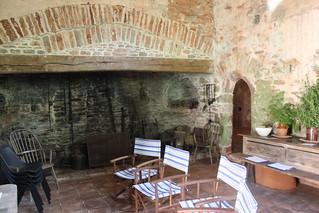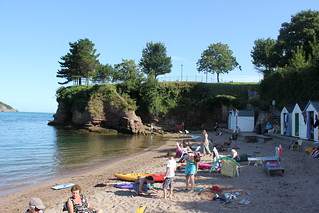Synopsis: A day out by train, boat and vintage bus, for Mum, Christine and myself. Spectacular journey on the Fairmile across Torbay to Brixham and then around Berry Head to Dartmouth.
We were going to sample, as this post title suggests, a goodly number of transport types today, more than we had at first imagined, but more of that later. Our first objective of the day was to get to Torquay by train for which purpose my sister-in-law drove us, Mum and myself, to Digby & Sowton rail station, where we caught the 8:40 train.
Yes, a relatively early start was required of us for our trip today. It’s such a lovely train journey this, as the railway follows the coast for quite some part of the way, and what could be better than to sit back, enjoy the ride, and take in the views?
We arrived in Torquay with plenty of time to stroll casually along Torquay seafront to Princess Pier, which is where we were to board our boat, the Fairmile. We passed the smart modern apartment block which has replaced The Palm Court Hotel and Café Mojo that burnt down in December 2010. Next to this new complex stands what I remember as an old toilet, but apparently was once a tollhouse (Grade II Listed). We walked the length of Princess Pier and there we saw the Fairmile, moored and waiting.
Our first alarm of the day occurred before we had even boarded the boat. We were informed that there were sailing restrictions and that we might not make it to Greenway. We were aware Dartmouth Regatta was on, but hadn’t expected this, especially as I’d only booked our excursion online the night before. Apparently it was critical that we made good time and were clear of the River Dart ahead of a planned parachute jump. To that end, we were soon sailing out of Torquay Harbour and headed out across Torbay.
There were splendid views of the shoreline of Torbay as we headed across the bay for Brixham. It was a bright crisp day, and the visibility excellent, and very little swell. It wasn’t long before we’d docked at Brixham where we collected additional passengers before sailing in the direction of Berry Head. I’ve visited Berry Head on a number of occasions, but this was the first time I’d sailed this stretch of coastline, so this was the first view of the impressive headland and its limestone quarry from the sea.
It was interesting to see from the sea a coastline that I’d walked on several occasions. The coastline between Brixham and Dartmouth makes for a very interesting walk, although it is quite physically demanding, which was very evident when viewed from the sea. I know this coastline well enough to recognise the various landmarks such as beaches and headlands that were visible from the boat.
What I found particularly appealing about this sailing was that it hugged the coastline pretty tightly, therefore we got a good close-up view of the coast as we sailed by. The sea was surprisingly calm, with very little swell. Here you see us passing Man Sands, a beach I’ve swum off in the past.
As we entered the mouth of the River Dart we were treated to good views of the two castles that guard its mouth, Kingswear Castle and Dartmouth Castle. It was interesting to get an ‘invader’s eye view’ of these castles. I believe a chain would once have been drawn across the mouth of the river, to deter ships from entering.
At Dartmouth we were scheduled to make a transfer from the Fairmile to Greenway Ferry. We (the three of us, and three others for Greenway House) were corralled by the crew of the Fairmile so that we might make a quick exit to catch the Greenway Ferry. It wasn’t long before Greenway Ferry docked at the jetty and we were boarding for the next stage of our journey up river to Greenway House (NT). I’d phoned ahead to say we were coming and the National Trust promised transportation would be laid on to carry Mum from Greenway Quay up to the house.
It was a little after one o’clock that we reached Greenway House so first priority was finding a place to eat our picnic that Christine had prepared for us. I headed towards the South Walled Garden & Vinery where I seemed to recollect there were benches, and I was not wrong. Soon we were perched and tucking into our salmon sandwiches and lemon drizzle cake, with a robin for company.
After lunch we thought we’d walk through the garden before tackling the house. I proposed we headed for the highest part of the garden (the Summerhouse), and Mum, perhaps surprisingly, said she was up for that. It’s worth the trek since there’s a splendid view to be had down the River Dart to Dartmouth and Kingswear.
We then chose to make off in the direction of the Boat/Bath House. Halfway down the hill Mum said she’d maker her way back to the house and wait for Christine and I there, which made sense, as we’d have to drop further still to reach the river. Unfortunately we were told the Boat/Bath House was closed, apparently for want of stewards, so sadly we didn’t get to see inside it (I suspect more dead bodies had been found inside). We then made our way past The Battery and climbed back up to the house where Mum was sat on a bench waiting for us.
We dropped our bags off in nearby lockers and entered the house. Agatha Christie and her husband Max were inveterate collectors, so the house is chuck full of interesting things to see. The house is also packed full, perhaps rather bizarrely, of what appears to be every edition of all of Agatha Christie’s books. I particularly liked some of the porcelain figures on display.
By now it was time to make our way back to Torquay. We had been informed by the crew of the Fairmile that there would be no return boat journey (as originally planned) because of sailing restrictions on the River Dart. Instead we were to use the vintage bus we were informed would depart at 17:00. The National Trust staff were a little concerned about us, as they thought the bus driver had gone home thinking there were no more passengers to collect, as we did not have regular bus tickets. A phone call was hastily made and the driver turned up, although he said he had not been told of us, grumbling a lot about lack of communications.
Anyway, it is a charming old bus, a 1948 build apparently, that rattles, shakes and bumps its way along the road, requiring considerable exertion on the part of the driver. You had to be fit in those days to drive buses, but any old slouch can do it these days. The driver gave us a commentary on the life of the bus and its characteristics as we went on our way.
We were dropped off near the harbour with plenty of time till our train would arrive. It was a pleasant summer’s evening so we sought out a harbour side café serving simple food which was all we really wanted. It was a nice way to round off what had been a very successful day. All that was left for us to do was walk to the railway station and catch our train home. A really pleasant and interesting day out it had been, one that each of us had enjoyed very much.
Trip Statistics:
Total Distance: 93.2 miles
Elapsed Time: 13hrs 12min (door-to-door – a long day)
Moving Time: 8hrs 00min
Stopped Time: 5hr 12min
Total Ascent: 759 metres
Maximum Elevation: 73 metres
Buses: Vintage (1948) bus from Greenway House to Torquay
Trains: Digby & Sowton (Exeter) to Torquay, off-peak day-return, 2 * £7.20
… One person travelling on a privilege ticket.













































